This is a Veteran Owned site

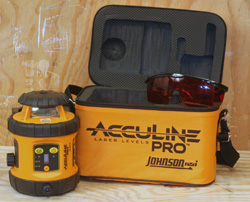 |
This kit includes a very nice, form-fitting padded carry case, the laser unit, AA batteries and a pair of red glasses to help see the line in bright conditions. Click image to enlarge |
Johnson Self-Leveling Rotary 800™ Laser Level
No hands leveling for the shop or worksite
Text, photos and video by Tom Hintz
Posted - 4-17-2011
There is precious little that a contractor or an even slightly Gung-Ho DIY/hobbyist can do that won’t benefit from a truly accurate level or plumb line of reference. If you don’t mind sprouting a plastic pocket protector I expect these points of reference can be determined mathematically. Since I dislike math that is more complex than remembering my PIN code I – and I expect lots of you – am way more interested in a modern day bit of electronics that shoots those reference lines all around the worksite and even levels itself. Enter the Johnson Self-Leveling Rotary 800™ Laser Level. Let us all face the East and give thanks to the leveling Guru’s at Johnson Level and Tool.
The Basics
The Johnson Self-Leveling Rotary 800™ Laser Level is an impressive looking unit that comes in an equally impressive form-fitting padded case that offers this tool very good protection. The body of the Johnson Self-Leveling Rotary 800™ Laser Level is formed from a tough-looking plastic with heavy rubber overmolds at all likely points of contact for when things get a bit rougher than we intended on the job or on the way to it.
The laser has a range of up to 200 ft indoors, depending on the light conditions.
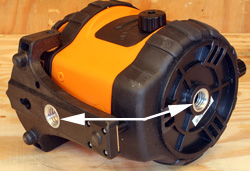 |
The unit has mounting bosses on the side plate and the bottom. You can also hang it from a screw or just stand it on a flat surface. Click image to enlarge |
Outdoors the Johnson Self-Leveling Rotary 800™ Laser Level can reach up to 800 ft if you use the optional detector. Trying to use virtually any light source in the sunlight hardly ever works on its own. A pair of red-lens glasses is included in this kit and makes seeing the laser in brighter conditions much easier, especially around indoor job sites.
The Johnson Self-Leveling Rotary 800™ Laser Level has a Laser wavelength of 635nm +/-10nm and uses a Class IIIa laser. It has a maximum power output <=5mW with an accuracy of +/-1/8" at 100ft. That is way better than most of us can manage with traditional bubble levels or water-filled tubes.
The Johnson Self-Leveling Rotary 800™ Laser Level is powered by four AA alkaline batteries as shown in this review. However you can use rechargeable NiCad batteries and even charge them in the unit with an optional charger. A charging plug is built into the side of the body and even has a tiny LED that lets you know that it is in fact charging. Expected battery life for the alkaline AA’s is about 20 hours of continuous use so for many of us the alkaline batteries are an economical choice.
The Johnson Self-Leveling Rotary 800™ Laser Level can be used on a hefty tripod, secured using the large 5/8” by 11 threaded inserts built into the bottom of the unit itself and into the side-mounted plate that can also be used as a mount or a stand for vertical work. This plate has a keyhole slot that allows hanging the unit from a screw driven into a wall on the jobsite.
The Johnson Self-Leveling Rotary 800™ Laser Level kit shown in this review includes rotary laser level, tinted glasses, 4 “AA” alkaline batteries, instruction manual and the aforementioned soft-sided carrying case.
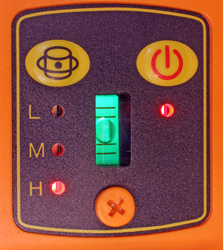 |
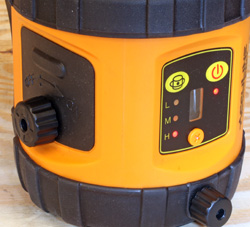 |
The controls (left) are very straight forward. The bubble vial in the center is backlit when the unit is turned on while standing on the side stand for projecting plumb lines. the larger knob on the side (right) locks the pendulum mechanism for transport and when using the unit for shooting a plumb line. Click images to enlarge |
|
The Johnson Self-Leveling Rotary 800™ Laser Level is 4.96" x 6.69" x 6.61" (126 x 170 x 168mm) and weighs 3.3 lbs. (1.5kg). This unit has a surprisingly wide operating temperature range of 14F to 113F (-10C to +45C).
Controls
A panel on the side of the Johnson Self-Leveling Rotary 800™ Laser Level groups the major controls. A simple power button has a supporting LED indicator that shows that it really is on. If that LED blinks it is telling you that it is time for new batteries. Another button on this panel cycles through the three speeds at which the laser emitter spins. You can choose between 200, 400 and 600 RPM. And, in the center of the control panel is a bubble level and we will see what that is for a bit later.
A large knob on the side of the Johnson Self-Leveling Rotary 800™ Laser Level is marked On and Off but it does not control the laser light. Rather this knob engages and disengages the protective locking mechanism that protects the pendulum system during transportation.
Auto-Leveling and Not
One of the things I could not figure out about the Johnson Self-Leveling Rotary 800™ Laser Level before getting it was how they got it to level itself on two separate planes 90-degrees apart. And as it turns out, neither could Johnson Level and Tool. The Johnson Self-Leveling Rotary 800™ Laser Level really is self-leveling in the upright position where it displays a horizontal level line, easily the most common use for most people. Set it on a surface that is within 3-degrees +/- of level and the internal pendulum system handles the rest.
The Johnson Self-Leveling Rotary 800™ Laser Level has a built-in audible and visual warning system that lets you know when it is more than 3-degrees from level when in the horizontal mode. This system is enabled when the locking knob on the side is turned to the ON position. A loud beep sounds and the laser stops rotating when the Johnson Self-Leveling Rotary 800™ Laser Level is more than +/- 3-degrees out of level. When the beeping sound stops and the laser begins rotating again, the unit is within the 3-degree +/- window and the pendulum system takes over and levels the laser system itself.
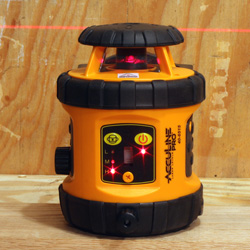 |
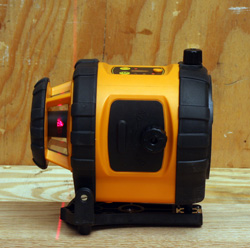 |
While shooting horizontal level lines (left) is far more common, this unit does plumb lines (right) also. Actually seeing the laser lines under our photo lights is pretty remarkable. |
|
Needing a vertical level (plumb) line is needed occasionally though far less frequently than a horizontal line. To project a vertical line the Johnson Self-Leveling Rotary 800™ Laser Level has a built-in stand on the side. Turn the locking knob on the side to the Off position where it locks the pendulum system and shuts off the laser so that you can then safely lay the Johnson Self-Leveling Rotary 800™ Laser Level on its side on that stand. Press the power button on the control panel to start the laser in that position. A smaller black knob now on the upper surface of the Johnson Self-Leveling Rotary 800™ Laser Level actually adjusts its angle in the stand. Watch the bubble level (now automatically backlit) in the middle of the control panel and turn the smaller know until the bubble is centered. That brings the now vertical line into plumb. This really is a fast, easy process thanks to the built-in adjustment and the hinged plate/stand.
Whenever the laser light is operating it shoots a separate beam straight out of the top to create a dot that is 90-degrees to the rotating beam. This can be a handy function for locating a position vertically or horizontally. I suspect that once you begin using the Johnson Self-Leveling Rotary 800™ Laser Level that dot coming from the top of the unit will offer many opportunities relevant to your work.
In the Shop
Using the Johnson Self-Leveling Rotary 800™ Laser Level really is very simple thanks to its design. The self-leveling feature makes setup very quick. The hardest thing to do in many situations is to decide at what height you should put the Johnson Self-Leveling Rotary 800™ Laser Level. Achieving a specific height might be easiest using a height-adjustable tripod but homemade stands or objects already at the job site remain viable options.
The light beam was easy to see in all of the applications I could think of. I even took the Johnson Self-Leveling Rotary 800™ Laser Level outside on a clear day and could still see the line without the glasses but way better with them on. I think that if the Johnson Self-Leveling Rotary 800™ Laser Level is to be used outdoors with any regularity getting the detector would be a good idea. The red dot being emitted from the top of the Johnson Self-Leveling Rotary 800™ Laser Level is also easy to see in a large range of light conditions.
Video Tour |
The controls are easy to understand and use and of course leveling in the most common upright mode is a snap. The 3-degree +/- range is usually easy to find for the pendulum to correct it but if your surface is off by more shimming the Johnson Self-Leveling Rotary 800™ Laser Level or the surface it sits on is made easier by the audible alarm.
I also tried laying the Johnson Self-Leveling Rotary 800™ Laser Level down on its stand and leveling that with the bubble vial. That also was very easy with the knob that turns an internal screw to adjust the angle. If you have the Johnson Self-Leveling Rotary 800™ Laser Level square to the wall, the line it shows is perfectly plumb.
Conclusions
If you do any kind of building or installation that requires a level line the Johnson Self-Leveling Rotary 800™ Laser Level will help you do the job accurately and probably in less time. The self-leveling feature lets you be sure of the projected line without a lot of messing around trying to shim a lesser laser unit or its stand to make it right. The Johnson Self-Leveling Rotary 800™ Laser Level has the features that you need on the job site and none of the extra fluff that does nothing for you but increase the price and often the complexity of use.
With a street price of just over $300.00 (4-16-2011) the Johnson Self-Leveling Rotary 800™ Laser Level is not nearly as expensive as I anticipated but it works like a high-dollar unit. The included padded case will make sure that the Johnson Self-Leveling Rotary 800™ Laser Level continues to perform for you over the long haul.
Visit the Johnson Level and Tool web site – Click Here
Have a comment on this review? –Email Me!
All written, photographic and drawn materials are property of and copyright by NewWoodworker.com LLC 2000-2019. Materials may not be used in any way without the written permission of the owner.

